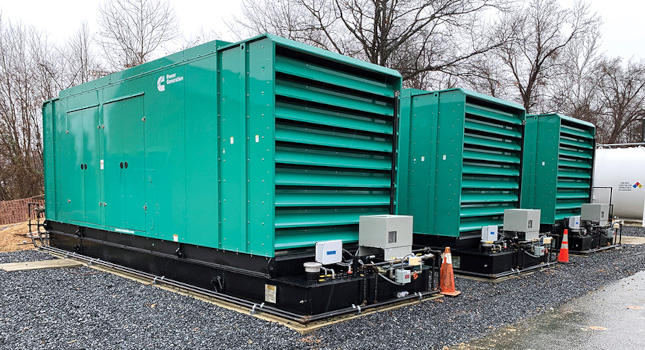Case study: Hospital emergency power upgrades
MedStar St. Mary’s Hospital emergency power upgrades
MedStar Health, a multihospital health system in the Baltimore-Washington metropolitan area, evaluated the condition and configuration of the generator and essential electrical systems (i.e., emergency power systems) at MedStar St. Mary’s Hospital. Working closely with the client, a conceptual design was developed by WSP USA, evaluating several potential options to upgrade the existing systems.
After review of the pros/cons and cost estimates for each option, MedStar determined the facility would be better equipped to serve the local community’s health care needs with an upgraded generator and associated electrical distribution equipment. The existing installation consisted of two 500-kilowatt diesel generators located adjacent to the central plant that were configured as two standalone emergency power systems.
In this configuration, each generator and associated electrical distribution equipment served roughly half of the hospital when a utility outage occurred. Additionally, the hospital determined there were several pieces of mechanical equipment (i.e., chillers, pumps, etc.) and patient care equipment (i.e., MRI, CT scans, etc.) that were only connected to normal power, which is code compliant that needed to be connected to emergency power for effective hospital operation during a utility outage.
Finally, the hospital identified the need to have the emergency power system configured in a manner that improves the reliability of the system in the event of equipment failure and allowed expansion of the system with future growth of the facility (see Figure 4).

Figure 4: Electrical single-line diagram indicating configuration of emergency power system and major equipment for MedStar St. Mary’s Hospital emergency power upgrades project. Courtesy: WSP USA
The anticipated demand load on the emergency power system after the system was reconfigured was 1,830 kVa. This anticipated load included equipment moved from normal power to emergency power. To support the existing hospital emergency loads and added equipment, three 750-kilowatt diesel generators were provided in a paralleled configuration.
The associated electrical distribution equipment was installed in a 1,100-square-foot emergency electrical building built adjacent to the generators. The system was configured so that a fourth generator could be installed in the future to expand the system’s capacity. The new generators have a total rated capacity of 2,800 kVa with an N+1 rated capacity of 1,875 kVa. Therefore, the upgraded generator plant has the capability to support all equipment in the event of a single generator failure which improves the reliability of the emergency power system at the hospital (see Figure 5).

Figure 5: Installation of three 750-kilowatt diesel generators in weatherproof enclosures at MedStar St. Mary’s Hospital installed as part of the emergency power upgrades project. Courtesy: CMI General Contractors
A critical component of the design was to maintain uninterrupted services to the community during this project. For this reason, the design team needed to carefully consider phasing of construction so that the impact to the hospital’s existing normal and emergency power systems was minimal. Location of new equipment was coordinated so that the existing generators remained operational until new system was online. An outage/phasing plan was developed during design and further refined with input from the electrical contractor to minimize the quantity and duration of outages.
The existing automatic transfer switches were upgraded, where possible and new automatic transfer switches with bypass isolation were installed to provide an emergency power system that supports the current hospital needs and future growth. The bypass isolation switches allow the hospital to perform preventive maintenance on each transfer switch without experiencing an outage to essential equipment which further emphasizes the importance of limiting disruption to hospital functions and patient care.
One of the major benefits of the new emergency power system configuration is that the chilled water system was connected to the emergency power system as part of this project. Connection of the chilled water system to emergency power allows the hospital to maintain space temperatures during any utility outage. Although the system only has the capacity to operate one of the two chillers while operating in automatic transfer mode, a manually operated nonautomatic transfer switch was provided to support the second chiller and associated pumps.
This provides the following benefits:
- The system design allows facility personnel the ability to monitor the load on the generators in real time and manually transfer the second chiller if needed for cooling demand when enough capacity is available at the generators.
- In the event the primary chiller is offline for maintenance, it allows facility personnel the ability to manually transfer the second chiller during a utility outage.
- If metering determines the actual peak demand load is less than what was calculated and generators have the capacity to support both chillers at peak load conditions, the nonautomatic transfer switch can be converted to an automatic transfer switch allowing the entire chilled water plant to automatically transfer to emergency when utility power is lost.
The emergency power upgrade project at MedStar St. Mary’s Hospital came with its challenges and was necessary so the hospital could continue to provide the highest level of care for the growing community served by this facility. The new generators and emergency power system ensure a reliable source of power is delivered to the hospital and is configured in a manner to allow for future growth and flexibility as the health care industry continues to evolve.
Do you have experience and expertise with the topics mentioned in this content? You should consider contributing to our CFE Media editorial team and getting the recognition you and your company deserve. Click here to start this process.



